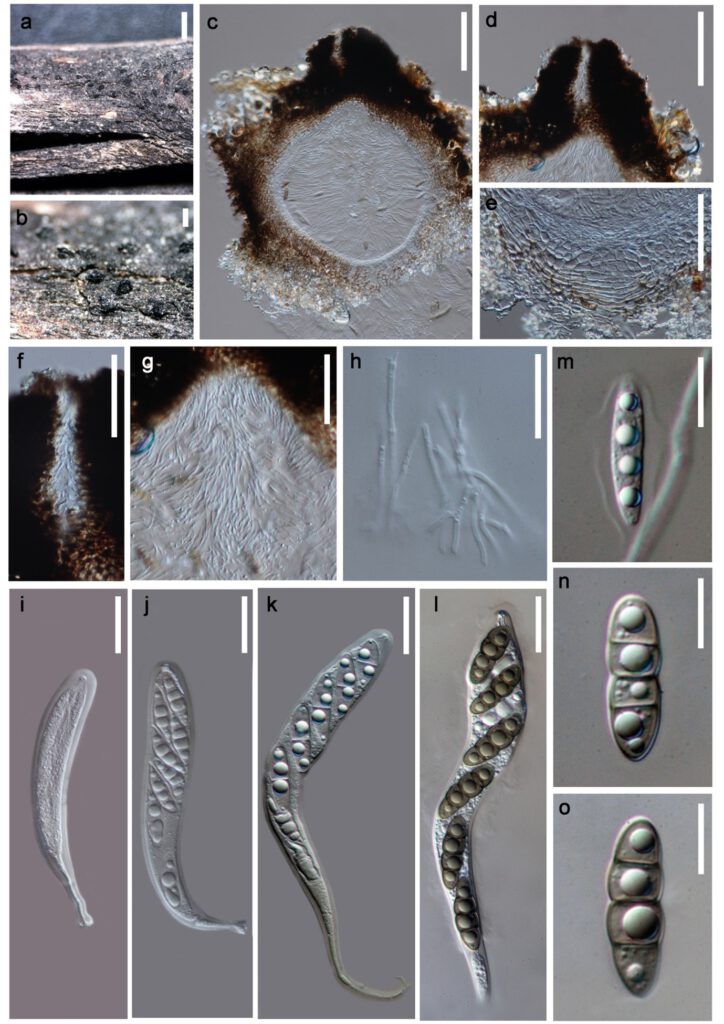Lophiostoma khanzada-kirgizbaeva Aluth., Gafforov & K.D. Hyde, sp. nov.
MycoBank number: MB 558817; Index Fungorum number: IF 558817; Facesoffungi number: FoF 10528, Fig. 2
Etymology: khanzada-kirgizbaeva (Lat.) in honour of Uzbekistan mycologist, Dr. Khanzada Kirgizbaeva (1937-2008) for her contribution in studying aquatic microfungi of Uzbekistan.
Saprobic on unknown hosts in terrestrial habitats. Sexual morph: Ascomata 170–450 μm high × 150–400 μm diam. (x̅ = 226 × 259 μm, n = 10), scattered to gregarious, immersed, dark brown to black, surrounded by a small blackened pseudoclypeus, globose to subglobose, ostiolate. Ostioles 120–140 μm high × 20–30 μm wide (x̅ = 130 × 25 μm, n = 5), slit- like, central, with a reduced crest and a pore-like opening. Peridium 35–80 μm wide (x̅ = 54 μm, n = 20), wider at the apex, and thinner at the base, composed of two strata, outer stratum comprising several layers of dark brown to black, somewhat flattened cells of textura angularis, fusing and indistinguishable from the host tissues, inner stratum comprising several layers with lightly pigmented cells of textura angularis. Hamathecium comprising 1–1.5 μm wide, septate, branched, pseudoparaphyses, situated between and above the asci. Asci 80–150 × 10–18 μm (x̅ = 113 × 15 μm, n = 30), 8-spored, bitunicate, fissitunicate, cylindric-clavate, with a long pedicel, rounded at the apex. Ascospores 15–25 × 6–8μm (x̅ = 22 × 7 μm, n = 50), uniseriate to bi-seriate, overlapping, initially hyaline and turning dark brown at maturity, fusiform with narrow rounded ends at immature state and turns ellipsoidal at maturity, 1–3 septate, constricted at the septum, widest at the region above or below the central septum, smooth-walled, guttulate, with mucilaginous sheath present in immature ascospores. Asexual morph: Undetermined.
Material examined: Uzbekistan, Jizzakh Region, Zaamin District, Zaamin National Nature Park, Supa Plateau in the Turkestan ridge of Pamir-Alay Mountains, on a dead branch of an Rosa sp., 15 July 2019, Yusufjon Gafforov, YG-Z75-1_1 (TASM 6158, holotype); ibid. on a dead stem of Rosa sp., YG-Z75-1_2 (TASM 6164, paratype).
GenBank accession numbers: TASM 6158 – LSU: OK017520, SSU: OK017525, ITS: MZ966265, tef1-α: MZ997338, rpb2:NA; TASM 6164 – LSU: OK017521, SSU: OK017526, ITS: MZ966266, tef1-α: MZ997339, rpb2: NA.
Notes: Lophiostoma khanzada-kirgizbaeva (TASM 6158) is phylogenetically closest to L. paramacrostomum (MFLUCC 11-0463). Our strain L. khanzada-kirgizbaeva (TASM 6158) composed of globose to subglobose ascomata while L. paramacrostomum (MFLUCC 11-0463) composed of subglobose to conical ascomata (Thambugala et al. 2015). Lophiostoma khanzada-kirgizbaeva (TASM 6158) consists of 1–3 septate, fusiform, hyaline ascospores, which turn ellipsoidal and dark brown at maturity. Lophiostoma paramacrostomum (MFLUCC 11-0463) is characterized by 1-septate, hyaline, fusiform ascospores with narrow, acute ends. The phylogenetic analysis of combined SSU, ITS, LSU, tef1-α, rpb2 sequence data of Lophiostomataceae species revealed the placement of our strain Lophiostoma khanzada-kirgizbaeva (TASM 6158) within the Lophiostoma clade with good statistical support (97% ML-BS/0.91 BI-PP, Fig. 1). Hence, confirming Lophiostoma khanzada-kirgizbaeva (TASM 6158) as a new species.

Fig. 2 Lophiostoma khanzada-kirgizbaeva (TASM 6158, holotype). a-b Appearance of ascomata on host surface. c Vertical section of ascoma. d, f Ostiolar canal. e Peridium. g, h Pseudoparaphyses. i-l Asci. m–o Ascospores. Scale bars: a = 1 cm, b = 300 µm, c, d = 100 µm, e–g = 50 µm, h–l = 20 µm, m–o = 10 µm.
